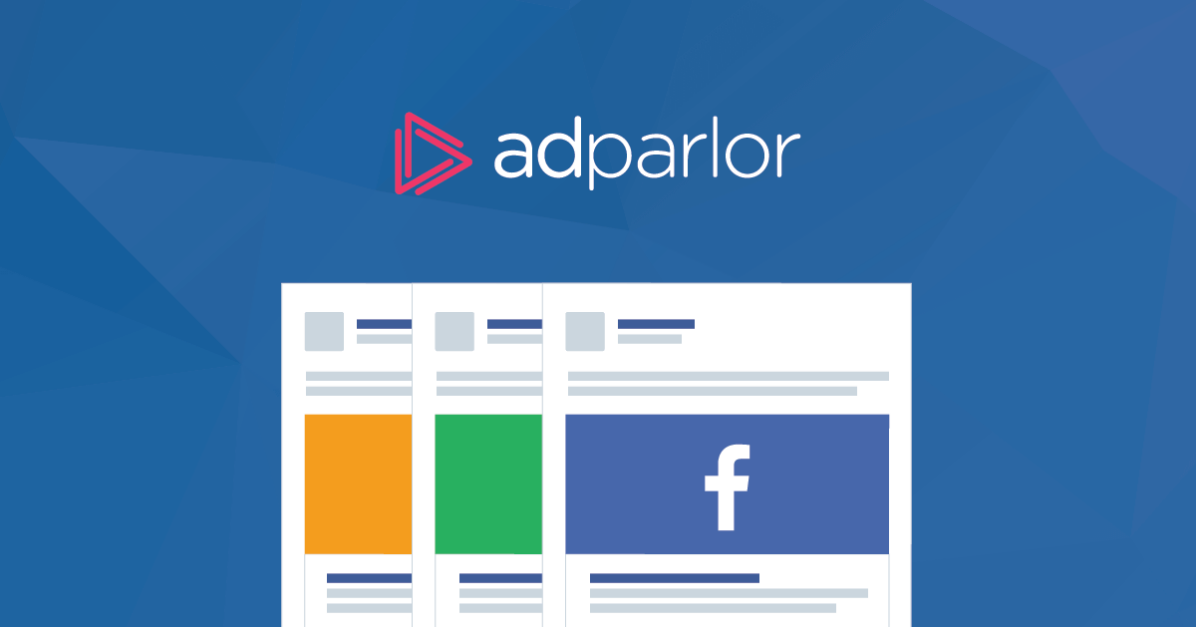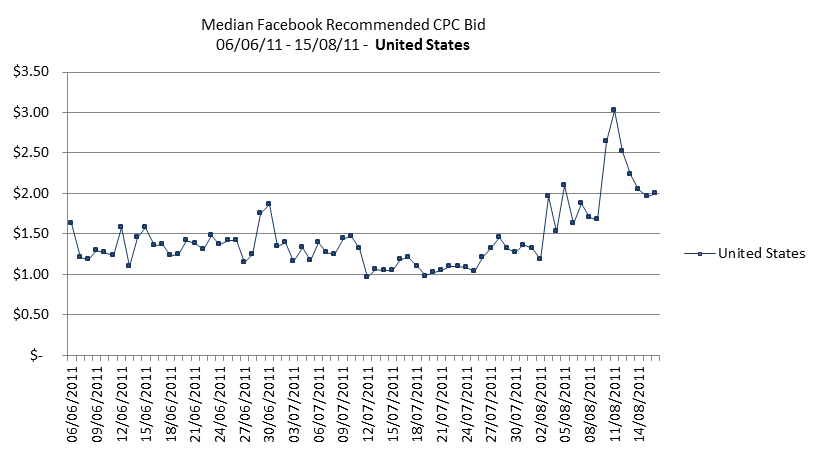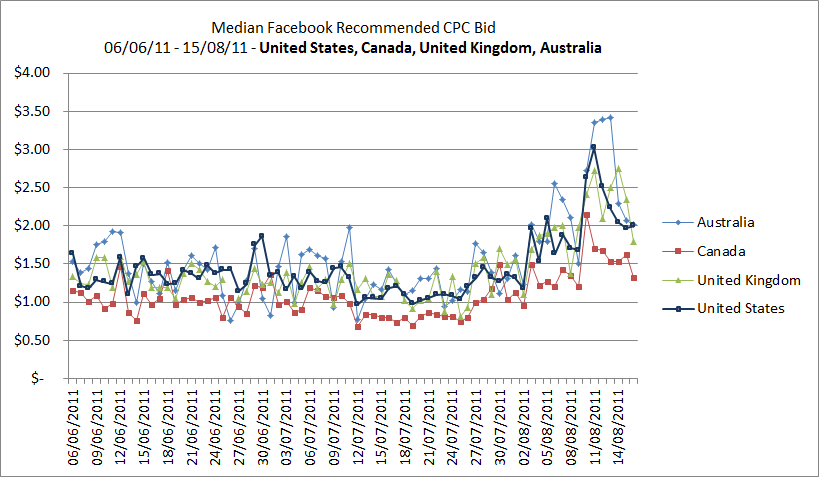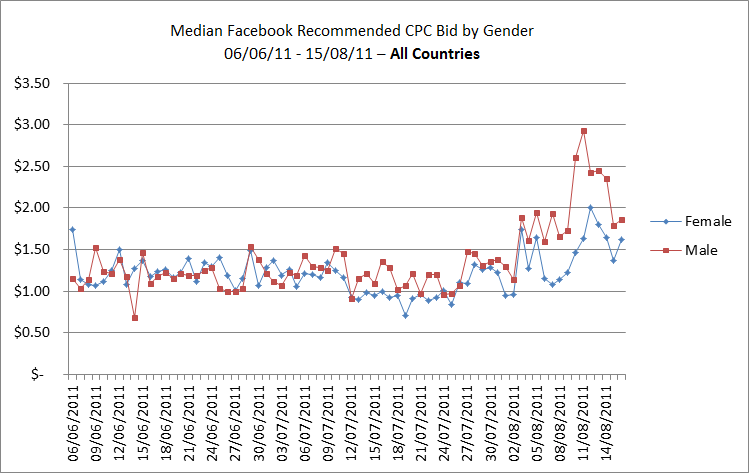The Dynamic Facebook Ad Marketplace – Tracking changes in Supply and Demand

One of the most interesting metrics we track is the Facebook recommended CPC (cost-per-click) bid. When creating any ad through their self-serve tool, Facebook offers a suggested bid based on the demographics you have selected. This recommended bid is a dynamic calculation that reflects the real-time state of competition within the marketplace. For a new account, Facebook will assume that you can achieve an average CTR of 0.04% and suggest a fair CPC bid for your ad based on what other advertisers are bidding in order to achieve impressions.
Naturally, demographics where there is more ‘supply’ and less ‘demand’ will be cheaper and vice versa. For example, if you wanted to target all 13-17 year olds in the US, Facebook would recommend a low CPC bid. This is because there are many of these users available; they tend to spend a lot of time on the site; and they are more likely to click on advertising. On the flip side, if you micro-target a small sector of female alumni in an affluent city, your recommended CPC bid would be higher as you are going after a small population, and there is a lot of competition for these users. This analysis of recommended CPC bids based of a certain demographic is definitely interesting, but the real fun begins when we analyze these values on a macro-level.
Overall, across multiple demographic and targeting segments, what is Facebook recommending to advertisers to bid for a click? Is there a variance between males and females? How do these values fluctuate over time? At AdParlor, we create thousands of ads every day through the Ads API and closely monitor these recommended CPC rates for changes in market conditions. This allows us to take advantage of segments when clicks are cheaper – and even shift budget according to the dynamic market conditions. What we have done is averaged out the recommended CPC rate every day using the median recommended bid of all the ads that were created that day. The ads created represent an accurate cross section of demographics and aggregately provide a strong picture on the market conditions. Let’s begin by looking at the data in the US from June 6th, 2011 – August 15th, 2011.

The first thing to note, is that recommended CPC bids fluctuate a lot day-by-day. The average median recommended CPC price in the US over this time period is $1.44. While a lot of the values fall around this line, there are noticeable trends away from this average. In the period between July 12th and July 25th, the rates stayed consistently around $1.07 before jumping back up. More recently, we have seen a significant jump since August 3rd, with a significant spike on the 10th and 11th of this month. Let’s take a look at the factors that can explain these fluctuations:
1 – A change in supply –the number of users, and their usage on the site can fluctuate over time. For example, there is a lot more usage on weekends than there is on weekdays. Additionally, Facebook is always making changes in the way ads are served to serve more valuable impressions on the site and this also has an impact. For example, adding a 4th ad to the homepage or having ads rotate after a period of inactivity are both ways Facebook can increase the number of impressions available in the market, and hence can drive down market prices.
2 – A change in demand – While a large portion of Facebook advertising is done within the long-tail, there are certain advertisers, that can have a significant effect on the market. If one of these big spenders decides to take a break from advertising, or put the foot on the pedal, we can expect to see fluctuations in the market. Similarly, groups of advertisers can have the same effect. We notice a very marked increase in prices during Christmas – as retailers compete for Facebook impressions. This could explain the spike we are now seeing as ‘back-to-school’ campaigns begin to flood the marketplace.
3 – An algorithm change – The Facebook ad serving algorithm is constantly changing. In fact, even the recommended bid presented is a calculation that is always changing. Often, the smallest change in Facebook’s code can have a real or perceived change in the way ads are served, and the recommended pricing for those impressions.
Because all three of these factors are constantly competing with one another, it is difficult to conclude the real reason for the change in the recommended CPC price. Looking at data for other countries starts to make things even more interesting. Mapping the United Kingdom, Canada, and Australia on the same graph as the United States, we can see that these countries follow a similar trend. If this fluctuation is due to a major advertiser, or group of advertisers, it seems that this effect spans across multiple countries.

While there is no real way of knowing exactly what causes these fluctuations in market conditions, it is important to understand that it does happen! The value of your bid one day can vary greatly from the next with the always-changing ad marketplace on Facebook. Be aware of this effect and realize that there is no direct answer to ‘How many impressions will I get if I bid $X on Facebook?’
One final graph with the data we have collected illustrates the difference between males and females across all countries. It seems that while prices for both genders spiked up last week, it can be primarily attributed to males.
